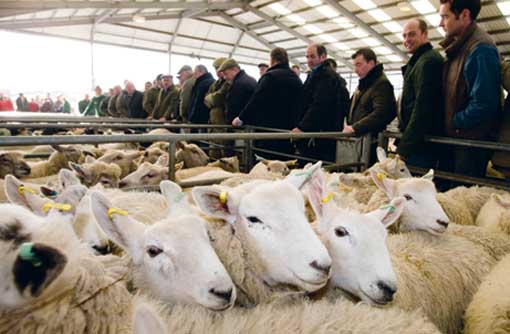How to make money from finishing store lambs

Buying at a price that enables autumn-bought hill-bred store lambs to be kept long enough to earn the best margin is the key to North Yorkshire farmer David Pighills’ indoor finishing system.
Several hundred lambs – all sourced through an agent – are finished at Club Nook Farm, Barden, near Skipton.
This year will be the second season when the best Swaledale lambs are sold through the Swaledale Sheep Breeders Association’s lamb marketing scheme set-up with Marks &Spencer.
Sourcing store lambs
“I don’t really want to be paying much over £25 for store lambs. At that price I’ve got the flexibility I need in terms of the costs involved in keeping the lambs until I feel they’ll give me a decent return.
Last year certainly wasn’t easy for lambs sold in the New Year but the Swaledales sold on the M&S scheme did well,” says Mr Pighills.
The first of the season’s hill-bred lambs arrive in October and into November and undergo a strict routine before being housed in the strawed finishing shed. Nothing is turned out to grass.
“I don’t want to risk any health problems being passed to my own sheep so all the lambs I buy go straight inside when they arrive. And everything stays in the same batch – there’s no mixing,” he says.
Mr Pighills buys a wide range of hill-bred lambs for finishing with most of the Swaledales weighing about 20kg. He makes sure everything gets jabbed with terramycin to stop any pasturella getting a hold.
“Over the last five years I’ve learnt this is absolutely essential. If we vaccinated them it just wouldn’t work fast enough to cope with lambs that might be carrying infection, so every lamb gets 2.5-3ml of terramycin.
“We also worm everything to tackle any fluke and worm problems. Last year we certainly had some lambs that just didn’t thrive as well as they should have done, but they improved after the fluke treatment. We also give a dose of multivitamins and minerals.”
All lambs are sheared, not only because Mr Pighills says they do much better without the wool on, but because he can get more into the shed.
Nutrition
Lambs are fed a 15% finisher pellet – either hand fed in troughs or in hoppers. “We’ve started off by feeding in troughs this season; lambs are getting about 0.7kg a head a day and it’ll help us just tick them over for a while.
Last year we had too many lambs ready by January, so this time we don’t want to push them on too soon.
“We’ll keep them on the troughs until the beginning of November, but will switch to hoppers as numbers increase over the coming weeks. Feed intakes go up quite a lot once we move them on to hoppers,” he says.
Ideally lambs are on the farm for 10-12 weeks. “But it doesn’t always work out like that as anyone with experience of hill lambs will tell you.
Finishing these lambs is all about having plenty of flexibility in the system because in the autumn it’s impossible to know when the best time will be to sell them.”
Marketing
Mr Pighills normally does not sell lambs weighing less than 40kg. “But lambs for the M&S scheme shouldn’t really be under 38-39kg although others could get up to 45kg.
All lambs are sold deadweight and the best Swaledale lambs for the scheme go through the Swaledale Sheep Breeders Association.
“The M&S lambs are worth a 15p a kilo bonus, but about a week before they go we take them off the hoppers and switch to trough feeding to make sure they stay within the specification weight.”
Mr Pighills reckons monitoring feeding is the key to finishing hill-bred store lambs well. “Overfeeding is the big risk.
It’s much easier on hoppers, but they eat more. Lambs sold on the Swaledale scheme last year did well for us, but others that went deadweight in December and January were a disaster in terms of the margin they left.
“If you could trough feed all the time these hill lambs will grow rather than just get fat, but for troughs you need more space and more time. With hoppers they can take up to 1.1kg a head towards the end of the finishing period.”
Buying the best quality lambs isn’t always the way to make the best margin out of hill-bred stores, reckons Mr Pighills.
“Buying the best hill-bred lambs in early October gives you lambs that are ready too soon. This season’s prices have ranged from as little as £22 to up to £45, but compared with last year I think there should be enough decent lambs about at reasonable prices.
“For me the cheaper they are the better chance I stand of making a fair margin without compromising on the quality.”
